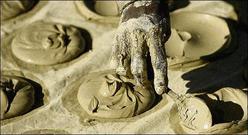
The hand of a woman is covered in mud as she makes mud cookies. - AP
PORT-AU-PRINCE, Haiti (AP):
It was lunchtime in one of Haiti's worst slums, and Charlene Dumas was eating mud.
With food prices rising, Haiti's poorest cannot afford even a daily plate of rice, and some take desperate measures to fill their bellies.
Mud cookies
Charlene, 16, with a one-month-old son, has come to rely on a traditional Haitian remedy for hunger pangs: cookies made of dried yellow dirt from the country's central plateau.
The mud has long been prized by pregnant women and children here as an antacid and source of calcium. But in places like Cite Soleil, the oceanside slum where Charlene shares a two-room house with her baby, five siblings and two unemployed parents, cookies made of dirt, salt and vegetable shortening have become a regular meal.
"When my mother does not cook anything, I have to eat them three times a day,'' Charlene said. Her baby, named Woodson, lay still across her lap, looking slightly thinner than the slim 6 pounds, 3 ounces (2.8 kilograms) he weighed at birth.
Though she likes their buttery, salty taste, Charlene said the cookies also give her stomach pains. "When I nurse, the baby sometimes seems colicky too,'' she said.
Floods and crop damage from the 2007 hurricane season forced the agency to declare states of emergency in Haiti and several other countries.
High Food prices
At the market in the La Salines slum, two cups of rice now sell for US$0.60, up US$0.10 from December and 50 per cent from a year ago. Beans, condensed milk and fruit have gone up at a similar rate, and even the price of the edible clay has risen over the past year by almost US$1.50. Dirt to make 100 cookies now costs US$5, the cookie makers say.
Still, at about five cents apiece, the cookies are a bargain compared to food staples.
Merchants truck the dirt from the central town of Hinche to the La Salines market, a maze of tables of sweet-smelling vegetables and meat swarming with flies. Women buy the dirt, then process it into mudcookies in places such as Fort Dimanche, a nearby shanty town.
Carrying buckets of dirt and water up ladders to the roof of the former prison for which the slum is named, they strain out rocks and clumps on a sheet, and stir in shortening and salt. Then they pat the mixture into mudcookies and leave them to dry under the scorching sun.

